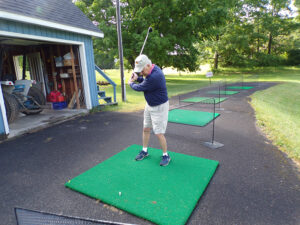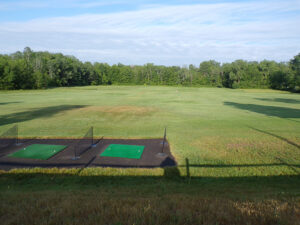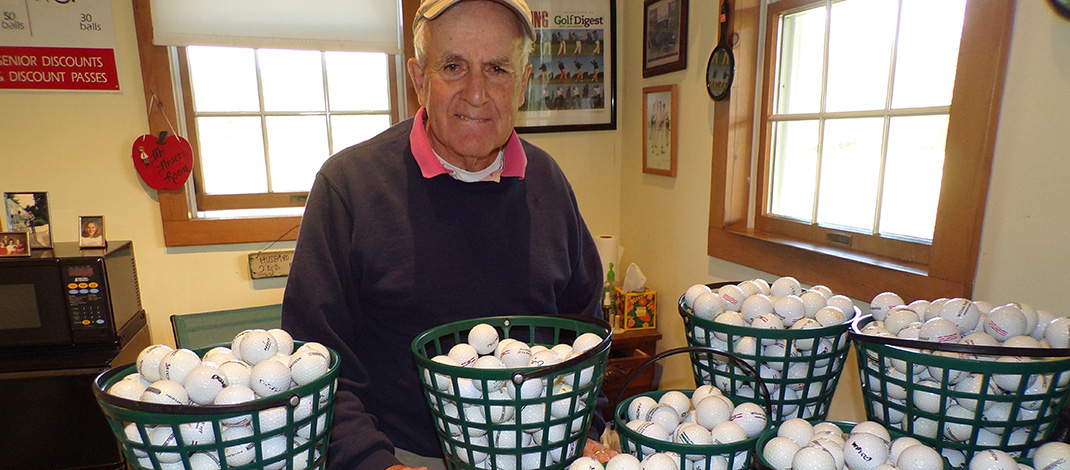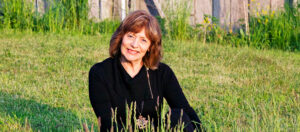Owner of Fulton Driving Range has been on the job for over 62 years … and he’s still going
By Stefan Yablonski

Bill Niver may be retired, but he’s not one to just putter around. At 82 he still has a lot of drive. He owns the Fulton Driving Range, just south of Battle Island State Park Golf Course on Route 48.
His name is actually Charles. At one point, the family started calling him Bill and it stuck, he said.
Niver has owned his driving range for a while, a long while — more than 62 years to be exact; since 1960. He has remained active to this day.
“I retired, but I’m not one to just sit around and do nothing. I am a retired school teacher, elementary, kindergarten mostly,” he said. “This has always been part-time, obviously. It’s a nice little thing to do — especially in the summer. Mid-April to mid-September is really the biggie season. We do a pretty good business. It tends to slow down a bit in September.”
The good weather has brought people out.
For every good day, you usually get a bad day —“it all evens out by the end of the year. You shoot for like 140 days. You don’t always get there,” he said. “No matter, it’s all part-time; all for the fun of it and that really explains it, I think.”
Retired ‘not quite’
Niver retired from the North Rose Wolcott School District. His wife, Jean, retired from Hannibal Central School.
“She was an elementary teacher, too. We retired in ’05. But as you can tell, we don’t quite retire. You just switch gears,” he said.
The couple celebrated its 50th wedding anniversary on June 23.
There are baskets of golf balls on the counter. Large baskets, medium baskets and smaller ones for folks who only want to hit a dozen or so balls.
“There are probably more than 6,000 balls,” he said. “There are several bins of balls in the other room. Never really took the time to count them all. Have added a lot over the years.”
It’s just him that goes out and collects them all, he explained, adding, “Somebody’s got to do it.”
“I get my exercise. Everybody runs off to the gyms and the Ys — which is a good thing to do — I get my exercise right here,” he laughed. “I spend an hour or so walking around getting the balls, getting exercise!”
He uses a shagger, a tube with a bag attached to the top — punches it over a ball and it’s yanked into the bag.
He has nearly two dozen of the things hanging from the ceiling in his store room.
The shaggers are similar to what the ball boys use at tennis events. “You see them run down and shag a ball with one of these … it’s the same thing I do,” he added.
“I’ve got a bunch of them. They tend to wear out — been here more than 60 years — I wear out too, but not as fast,” he quipped. “But still you gotta do what you gotta do.”
 He also has an apparatus that he can attach to a golf cart to expedite his ball retrieval jaunts.
He also has an apparatus that he can attach to a golf cart to expedite his ball retrieval jaunts.
“I have an automatic picker, but I’d rather not use it. If you want to get your exercise, why are you going to ride around in a golf cart? I spend about an hour in the morning picking up balls,” he said.
His younger brother (he’s 64) helps out some days from noon to 4 p.m. And he has a girl that comes in on weekends.
Around a dozen Astroturf mats are situated with tees for right- and left-handed golfers. The mats cost $300 apiece, he noted.
Mowing the vast field also takes a good chunk of time, he added.
Some times, early in the season, the ground is soft and a few balls disappear into the ground — some are found later, “When I am mowing.”
“You spend quite a bit of time mowing — that really occupies your time. We’re open eight hours a day; I’m here two to three hours more than that because someone has to pick up the balls and do the darn mowing,” he said. “You can’t mow until all the balls are out of the way. You’ve got to avoid hitting the darn balls [with the mower]. It’s a pain, a small one, still a pain. No matter how good you pick, there’s always eight to 10 golf balls left out there somewhere.
“Doesn’t sound like much — but if you’re mowing, you have to get off and on eight times — it’s a pain. They’ll come out of a mower pretty fast. And not in the best condition, either! I’ve never been hit by one and I don’t want to be.”
Niver also has to wash the balls. If it’s in the spring, the balls get pretty darn dirty, he noted.
He’s “pretty well set for next year.” He’d rather not buy balls every year if he can avoid it … “but you tend to lose a lot during the season. You don’t usually throw out any. But you do if the mower hits one — however, you try not to do that,” he smiled.
Flags of various colors denote the distances on the driving range.
“It’s rare that someone can reach the 250 yards flag. But there are some ‘long-hitters.’ I usually find a few balls, five or six, that I missed picking up and some have been out that far. That’s a pretty potent punch [to reach that flag],” he said.
Most hit between the 100 and the 50 yards flags.
Golfers go to ranges to get in some practice. But it’s mostly people who are just getting going with the game and want to improve. They want to straighten out the ball that goes this way and that way, he added.
How much did it cost to get started all those decades ago?
“I can’t put a number on that. But it was marginal compared to way things are now,” he replied. “It was fairly cheap. I could pay off it in two years.”
Since then he has added a few things, more clubs, the mower, a golf cart — and “a lot more balls.”
“You add a few things over the years as you’re able,” he said. “It’s a part-time thing, but it’s worked out pretty good in the sense that it’s a good idea to keep going,” he said.
“I don’t want to stop [working]. But, if I did, I’d still push myself and keep going — keep doing something — get up in the morning and go do something! This is a good thing to do five or six months out of the year and meet people,” he said.




